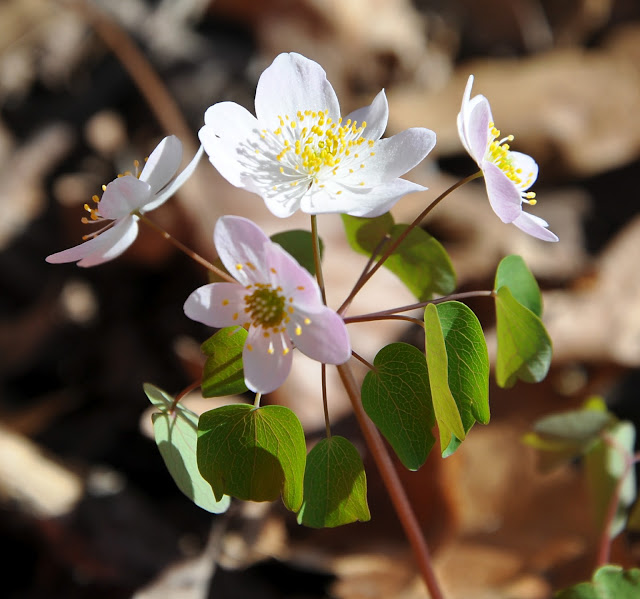Some excellent marks, at least currently, to definitively recognize Zena in the field by her tail, from Sally of Kentucky--
I only see 2 feathers with a dark terminal band, most just
have a white tip. Plus the right outer feather is pale and shows perhaps a stress
mark? Its misshapen. Good ID for her until she molts at least. :)
It will be very interesting to see if after the next molt she retains the lack of a terminal band on most of her tail feathers.
Photo by Donegal BrowneA couple dozen of these plants were discovered in a woods that was being cleared of invasives. As my Peterson's Field Guide to Wildflowers has currently done a disappearing act, I'm tentatively identifying them as Rue Anemone. Though I'm perfectly willing to be corrected by someone whose field guide hasn't taken a powder or who knows for sure in the first place.
Photo by Donegal Browne
By the way, see the red stems? Each of those stems appears to be an individual plant, though I've not dug them up to make sure.
Speaking of which, I've flagged the individual plants, there are only perhaps two dozen or so in the woods which is marked to become show grounds for the Rock River Thresheree, hoping that the skid steer which is roaring around in said woods removing stumps and Asian Honeysuckle doesn't squash them. Or that the small engines which will be displayed in the woods for three days each year won't take total precedence over these wildflowers which may have been discovered in only the third county in the state (the National Resource Conservation Service only knows of two in WI) where they still live, by the possible insistence of the Small Engines Committee that a road and paths must be installed over the top of where the flowers currently grow for the ease of exhibitors.
Just in case they're doomed where they are, I've made some inquiries as to the odds of at least some of the the plants living through being transplanted to a safer location.
Why is it always something?
Photo by Donegal Browne
But back to our inquiry, note that though this plant has much the same shapes when it comes to leaves and sepals as the plants above. (No, those petal looking things are not petals they are technically sepals.)
The coloration of the leaves is strikingly different, and the sepals pinker in this model than those above particularly before opening.
A different species? A subspecies?
Donegal Browne
P.S. NYC Audubon is collecting information from those of us who are members of the NYC Raptors Group about the location of all known Red-tailed Hawk Nests in all the boroughs of NYC in hopes of relaying the information to those who are responsible for placing rat poison in the parks in hope of finding some kind of compromise that could help stop the continuing epidemic of Red-tail deaths in New York City. Particularly as we are now going into breeding season when dense hunting occurs.




No comments:
Post a Comment